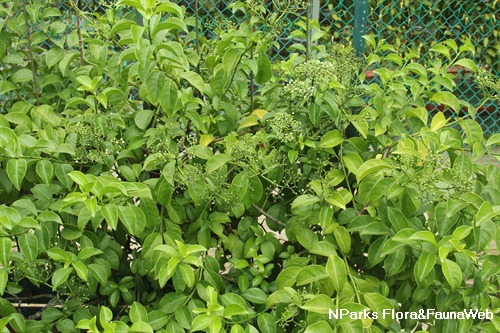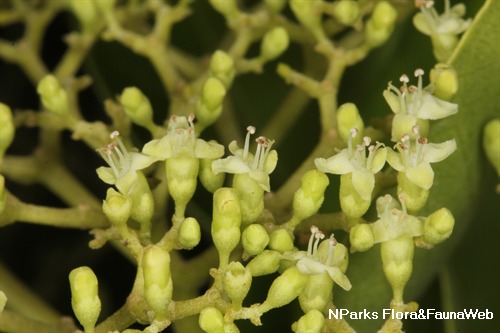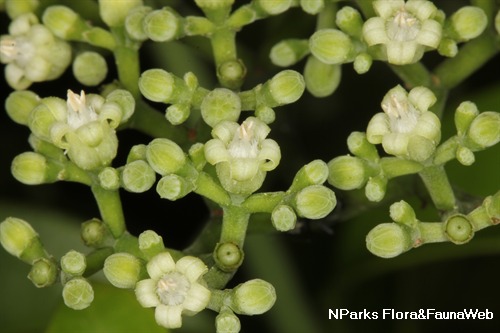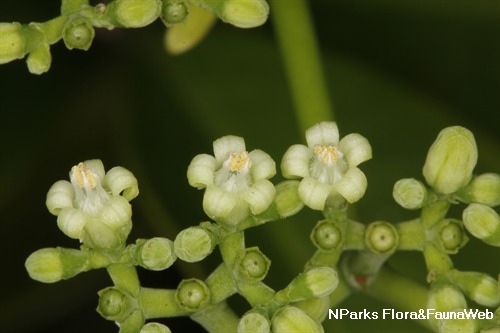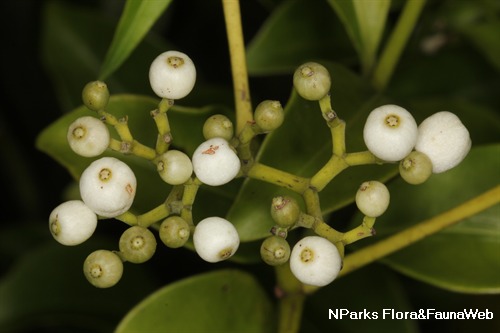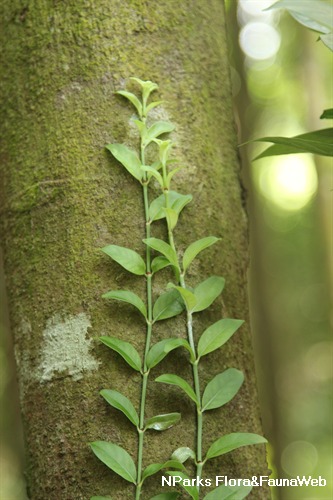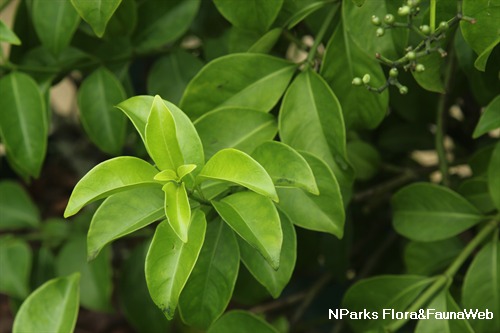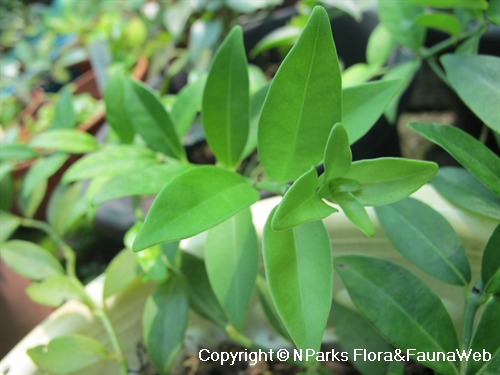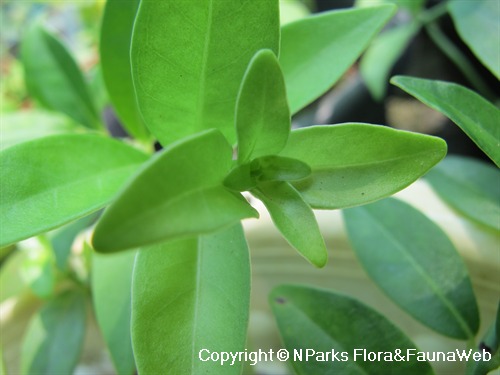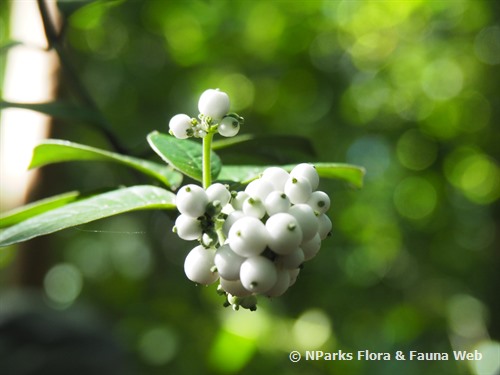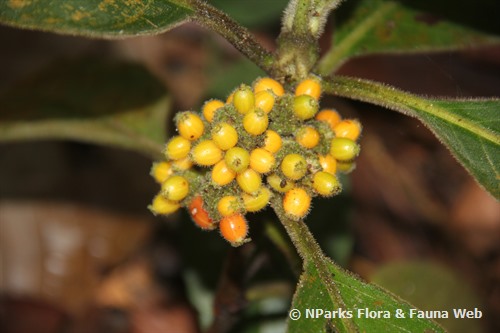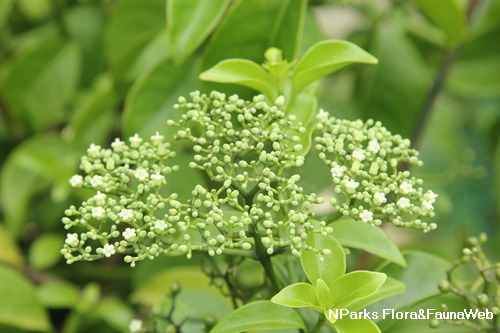
Back
Psychotria sarmentosoides Valeton
| Family Name: | Rubiaceae |
| Synonyms: | Psychotria sarmentosa auct. non Blume |
| Common Name: | Akar Daldaru |
Name
Classifications and Characteristics
| Plant Division | Angiosperms (Flowering Seed Plants) (Dicotyledon) |
|---|---|
| Plant Growth Form | Climber |
| Lifespan (in Singapore) | Perennial |
| Mode of Nutrition | Autotrophic |
| Maximum Height | 15 m |
Biogeography
| Native Distribution | India, Sri Lanka, Myanmar, Thailand, Peninsular Malaysia, Singapore, Java, and Borneo |
|---|---|
| Native Habitat | Terrestrial (Primary Rainforest, Secondary Rainforest, Freshwater Swamp Forest) |
| Preferred Climate Zone | Tropical, Sub-Tropical / Monsoonal |
| Local Conservation Status | Native to Singapore (Presumed Nationally Extinct (NEx)) |
Description and Ethnobotany
| Growth Form | It is a climber, often creeping with aerial roots on tree trunks, up to 15m long. |
|---|---|
| Foliage | Its opposite, stalked leaves have thinly leathery leaf blades that are elliptic, hairless or hairy below, and 6.3–10 by 2.5–4.4 cm, with 7–10 pairs of veins. |
| Flowers | Its greenish white flowers occur in many-flowered clusters at branch tips and are 3.8 mm long and shortly stalked. |
| Fruit | Its fruits are white and roundish. Its seed has four ridges. |
| Habitat | It grows in lowland forests, from sea level to 2300 m altitude. |
| Associated Fauna | Its flowers are insect-pollinated. Its fruits are eaten by birds. |
| Taxonomy | Previous name of Psychotria sarmentosa auct. non Blume was misused in Singapore. Current name of Psychotria sarmentosoides Valeton is applicable to wild plants in Singapore but not necessarily to wild plants elsewhere or to cultivated plants originating elsewhere. |
| Cultivation | It can be propagated by seed or stem cutting. |
| Etymology | Greek psychotria, refreshment, referring to the reputed medicinal properties |
| Ethnobotanical Uses | Medicinal: Its leaves are used to poultice sores. Some used it as a drug to expedite childbirth. |
Landscaping Features
| Landscaping | It may be suitable for parks. |
|---|---|
| Landscape Uses | Parks & Gardens, Small Gardens |
Fauna, Pollination and Dispersal
| Fauna Pollination Dispersal Associated Fauna | Bird-Attracting |
|---|---|
| Pollination Method(s) | Biotic (Fauna) |
| Seed or Spore Dispersal | Biotic (Fauna) |
Plant Care and Propagation
| Light Preference | Semi-Shade |
|---|---|
| Water Preference | Moderate Water |
| Plant Growth Rate | Moderate |
| Rootzone Tolerance | Moist Soils, Well-Drained Soils, Fertile Loamy Soils |
| Propagation Method | Seed, Stem Cutting |
Foliar
| Foliage Retention | Evergreen |
|---|---|
| Mature Foliage Colour(s) | Green |
| Mature Foliage Texture(s) | Leathery, Thin |
| Foliar Type | Simple / Unifoliate |
| Foliar Arrangement Along Stem | Opposite |
| Foliar Attachment to Stem | Petiolate |
| Foliar Shape(s) | Non-Palm Foliage |
| Foliar Venation | Pinnate / Net |
| Foliar Margin | Entire |
Floral (Angiosperm)
| Flower & Plant Sexuality | Bisexual Flowers |
| Flower Colour(s) | Green - Light Green, White |
|---|---|
| Flower Grouping | Cluster / Inflorescence |
| Flower Location | Terminal |
Fruit, Seed and Spore
| Mature Fruit Colour(s) | White |
|---|---|
| Fruit Classification | Simple Fruit |
| Fruit Type | Fleshy Fruit , Non-Accessory Fruit |
Image Repository
Others
| Master ID | 30792 |
|---|---|
| Species ID | 5146 |
| Flora Disclaimer | The information in this website has been compiled from reliable sources, such as reference works on medicinal plants. It is not a substitute for medical advice or treatment and NParks does not purport to provide any medical advice. Readers should always consult his/her physician before using or consuming a plant for medicinal purposes. |

